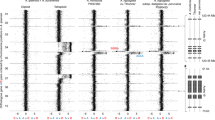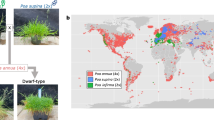Abstract
The bulb onion, Allium cepa L., is a diploid (2n=2x=16) plant with a huge nuclear genome. Previous genetic and cytogenetic analyses have not supported a polyploid origin for onion. We developed a low-density genetic map of morphological markers, randomly amplified polymorphic DNAs (RAPD), and restriction fragment length polymorphisms (RFLP) as a tool for onion improvement and to study the genome organization of onion. A mapping population of 58 F3 families was produced from a single F1 plant from the cross of two partially inbred lines (Brigham Yellow Globe 15-23 and Alisa Craig 43). Segregations were established for restoration of male fertility in sterile cytoplasm, complementary light-red bulb color, 14 RAPDs, 110 RFLPs revealed by 90 anonymous cDNA clones, and 2 RFLPs revealed by a cDNA clone of alliinase, the enzyme responsible for the characteristic Allium flavors. Duplicated RFLP loci were detected by 21% of the clones, of which 53% were unlinked (>30 cM), 5% loosely linked (10–30 cM), and 42% tightly linked (<10 cM). This duplication frequency is less than that reported for paleopolyploids but higher than for diploid species. We observed 40% dominant RFLPs, the highest yet reported among plants. Among duplicated RFLP loci, 19% segregated as two loci each with two codominant alleles, 52% segregated as one locus with codominant alleles and one locus with only a dominant fragment, and 29% segregated as two loci with only dominant fragments. We sequenced cDNAs detecting duplicated RFLPs; 63% showed homology to known gene families (e.g., chlorophyll binding proteins, ubiquitin, or RuBISCO), and 37% were unique clones showing significant homology to known genes of low-copy number or no homology to database sequences. Duplicated RFLPs showing linkage could be due to retroviral-like sequences in adjacent coding regions or intrachromosomal, as opposed to whole genome, duplications. Previous cytological analyses and this genetic map support intrachromosomal duplication as a mechanism contributing to the huge onion genome.
Similar content being viewed by others
Author information
Authors and Affiliations
Additional information
Received: 3 July 1997 / Accepted: 8 August 1997
Rights and permissions
About this article
Cite this article
King, J., Bradeen, J., Bark, O. et al. A low-density genetic map of onion reveals a role for tandem duplication in the evolution of an extremely large diploid genome. Theor Appl Genet 96, 52–62 (1998). https://doi.org/10.1007/s001220050708
Issue Date:
DOI: https://doi.org/10.1007/s001220050708




